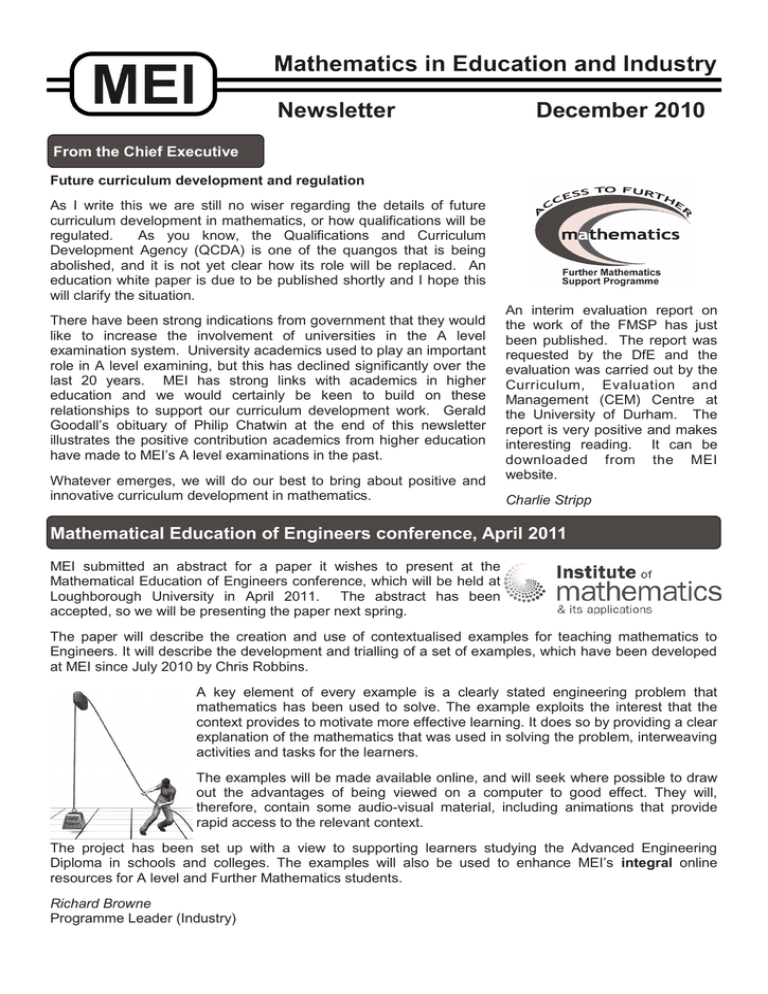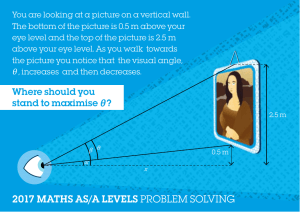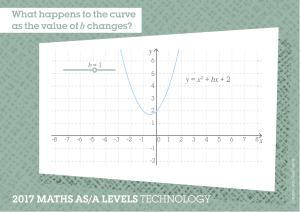Newsletter December 2010 From the Chief Executive
advertisement

Newsletter December 2010 From the Chief Executive Future curriculum development and regulation As I write this we are still no wiser regarding the details of future curriculum development in mathematics, or how qualifications will be regulated. As you know, the Qualifications and Curriculum Development Agency (QCDA) is one of the quangos that is being abolished, and it is not yet clear how its role will be replaced. An education white paper is due to be published shortly and I hope this will clarify the situation. There have been strong indications from government that they would like to increase the involvement of universities in the A level examination system. University academics used to play an important role in A level examining, but this has declined significantly over the last 20 years. MEI has strong links with academics in higher education and we would certainly be keen to build on these relationships to support our curriculum development work. Gerald Goodall’s obituary of Philip Chatwin at the end of this newsletter illustrates the positive contribution academics from higher education have made to MEI’s A level examinations in the past. Whatever emerges, we will do our best to bring about positive and innovative curriculum development in mathematics. An interim evaluation report on the work of the FMSP has just been published. The report was requested by the DfE and the evaluation was carried out by the Curriculum, Evaluation and Management (CEM) Centre at the University of Durham. The report is very positive and makes interesting reading. It can be downloaded from the MEI website. Charlie Stripp Mathematical Education of Engineers conference, April 2011 MEI submitted an abstract for a paper it wishes to present at the Mathematical Education of Engineers conference, which will be held at Loughborough University in April 2011. The abstract has been accepted, so we will be presenting the paper next spring. The paper will describe the creation and use of contextualised examples for teaching mathematics to Engineers. It will describe the development and trialling of a set of examples, which have been developed at MEI since July 2010 by Chris Robbins. A key element of every example is a clearly stated engineering problem that mathematics has been used to solve. The example exploits the interest that the context provides to motivate more effective learning. It does so by providing a clear explanation of the mathematics that was used in solving the problem, interweaving activities and tasks for the learners. The examples will be made available online, and will seek where possible to draw out the advantages of being viewed on a computer to good effect. They will, therefore, contain some audio-visual material, including animations that provide rapid access to the relevant context. The project has been set up with a view to supporting learners studying the Advanced Engineering Diploma in schools and colleges. The examples will also be used to enhance MEI’s integral online resources for A level and Further Mathematics students. Richard Browne Programme Leader (Industry) Page 2 CPD: Is MEI meeting your department’s professional development needs? If there are any professional development courses that you think MEI should offer, please fill in the short form that you will find at mei.org.uk/cpd Introduction to Decision Maths Two more one day courses, with follow up sessions in an online classroom, will take place in January. Wednesday, January 19 at St Christopher’s School, Accrington Friday, January 21 at the City of London Academy For further details and booking forms, please see the MEI website. Bernard Murphy Programme Leader (CPD) Twin GCSEs in Applications of Mathematics and Methods in Mathematics Twin GCSEs in Applications of Mathematics and Methods in Mathematics are being piloted by all awarding bodies. The philosophy underlying the design of the GCSEs is that students who take both GCSEs will be better prepared to use mathematics and to study it further. The content of the pair of GCSEs includes everything in the single Mathematics GCSE, along with a small amount of additional content. OCR are recruiting additional schools and colleges for their pilot. linkedpairmaths@ocr.org.uk To register interest, contact OCR have produced mock exam papers for the pilot which will shortly be available to teachers on OCR Interchange: ocr.org.uk/interchange/index GCSE resources The introduction of the new GCSE (both the single and the twin) means there is a greater need than ever for students to develop mathematical problem solving skills. The resources we are putting online address this by promoting a sense of visualisation to help students make sense of the mathematics. The Foundation Tier resources have been written by authors from Manchester Metropolitan University and the Freudenthal Institute using an approach which has been successfully trialled with students in a range of Manchester secondary schools for the last seven years. Real life contexts are used as the starting point to enable students to develop their mathematical thinking in a way which makes sense to them. Through working in this way, students are able to develop their understanding alongside their ability to solve problems. The resources are suitable for all new GCSE courses (teaching from 2010). Not all the resources are online yet; for latest news see mei.org.uk/gcse and click on the link to teaching resources. The sample teaching resources and scheme of work are free for anyone to use. The sample Higher Tier resources are for Venn diagrams; you may also find these useful for year 12 S1. Further resources will be added gradually. The full Higher Tier resources will not be available for a year or so as they are still being written and trialled. Stella Dudzic Programme Leader (Curriculum) Page 3 Online Resources survey report and prize draw winners After the MEI Online Resources were transferred to a new, more modern, VLE in 2009, we wanted to gain a better understanding of how our users engaged with the Online Resources. An online survey was held at the end of the spring term of the 2009-10 academic year, bringing responses from over 60 teachers and 240 students. In response to the feedback we have made further changes to the site, some of the most obvious being the contemporary new look, and the new name: integral. To address the navigation problems reported by some users, we have changed the interface to give clearer and more intuitive access to the resources and other features. The survey results can be accessed on the integral site at its new web address: integralmaths.org and at mei.org.uk A free prize draw was held for those who subscribed before the end of October. The winners were: The King’s School (Worcs), Plume School (Essex) and Mullion School (Cornwall). Another survey will be conducted in the spring of 2011, to evaluate whether the developments to the site have met the needs and wishes of our teachers and students. Sue Owen Marketing Officer Exam related matters Accuracy in Statistics examinations There was a statement about accuracy in Statistics units in the examiners’ reports for June 2010 for A Level Mathematics and for AS Statistics. It is reproduced here: mei.org.uk/examreport/2010 and includes the phrase: “Such gross over-specification indicates a lack of appreciation of the nature of statistical work and, with effect from the January 2011 examinations, will be penalised by withholding of associated Accuracy marks.” The next two items are in a notice to centres from OCR that was sent to centres at the end of November but I have permission from OCR to pass it on to you here. The full notice can be seen at mei.org.uk/OCRnotice/2010 Statistical hypothesis testing “Often in statistics questions, candidates are instructed to state their hypotheses when asked to conduct a hypothesis test. Occasionally, the specific instruction to state the hypotheses is omitted, but marks are awarded for doing so as this is part of the normal process of carrying out statistical tests. We would like to advise you that it will become more common for the instruction to be omitted in GCE Mathematics (MEI) and AS Statistics (MEI) papers. Candidates should continue to be taught that a clear statement of the hypotheses is a vital part of the test which will normally be awarded marks.” Printed Answer books and onscreen marking at A Level Further units will be marked onscreen in January and June 2011 and so will use printed answer books. Please ensure that your students know which of their exams will use printed answer books. Notice also that the June 2010 Examiners’ Report gives the following advice: “There are three matters that have been raised about how candidates should use the Printed Answer Books (that will be scanned). The first is that they should put their answers in the correct sections; the second is that they should not try to erase writing or drawing but should cross it out – the scanning process is sensitive and copies the faint images and marks that often are left after attempts at erasure. Finally it should be noted that the use of additional answer sheets should be unusual, and that sheets of rough working should not be handed in.” Stella Dudzic Page 4 Philip Chatwin Philip Chatwin, a former long-serving MEI Examiner and a distinguished applied mathematician, died of a heart attack in September at the age of 68. Philip was born in Chester, excelled at school, went to Cambridge and soon entered an academic career. For many years he was at the University of Liverpool; later he was appointed to a Chair at Brunel and subsequently moved to a Chair at Sheffield. Although officially retired, he remained active with academic work. His area of special interest was at the fluid dynamics end of classical applied mathematics, especially atmospheric dispersion and turbulent diffusion. He researched extensively in these areas, publishing many papers. The applications he studied included the dispersion of gases – noxious or otherwise – in the atmosphere, emission of smoke from large chimneys such as those of power stations, and dispersal of effluent in river estuaries. Another area of his research was concerned with the plastic packaging that is so common on food nowadays, and especially the problem of "migration" of the plastic into the food itself. At first sight a very different area, in fact the same sorts of models apply here as to gas dispersion – yet another illustration, if one were needed, of the power of mathematical modelling. For those of you who are into this sort of work, the key model is that of the Navier-Stokes equations. These have no closedform solution except in very special cases and therefore some very interesting advanced mathematics is needed in order to study them. As well as being a notable authority in the mainstream of this work, Philip was ahead of his time in bringing statistical ideas into play in it. As the atmosphere is, by its nature, turbulent, he argued that a proper understanding of its behaviour could only be achieved by introducing ideas based on randomness. This work was, and to some extent remains, controversial; not everyone accepts the basic premise. Nevertheless, this seems to be the way that modern work is going and it may well be that, in the future, Philip's greatest contributions will be seen to have been here. As well as being a leading researcher, Philip was an energetic and committed teacher. When he was appointed to Brunel, he immediately took on the first-year course in basic mathematical methods – not many newly-appointed Professors of Mathematics would do that! A little later, he took the first year statistics course too. It was a mark of the man that he was always willing to "get his hands dirty" in this sort of way. Philip was involved with MEI from very early days. He set the applied mathematics parts, both the mechanics and the statistics, of the former single-subject A-level Mathematics papers, with his very good friend Lewis Hildyard dealing with the pure mathematics. I first met him way back in 1977 when I was appointed as a reviser of these papers and I have worked with him in many ways, both within MEI and academically, for much of the time since. It is both a pleasure and a privilege to have known him professionally. He also became a good personal friend. It was very easy to make friends with Philip. "Forceful" is not a strong enough word to describe his character (!), but never aggressive, always open to discussion, pleasant and affable, generally fun to be with – professionally or socially. His funeral was in Sheffield on 29 September. The crematorium was full, standing and overflowing. People had come from many places, from long distances. Such was the man. He will be very much missed. There were giants in those days. Gerald Goodall MEI Chair We hope that you will find this newsletter useful; however, if you do not wish to receive further issues, please email sue.owen@mei.org.uk with UNSUBSCRIBE and the name of your school or college in the subject line.

